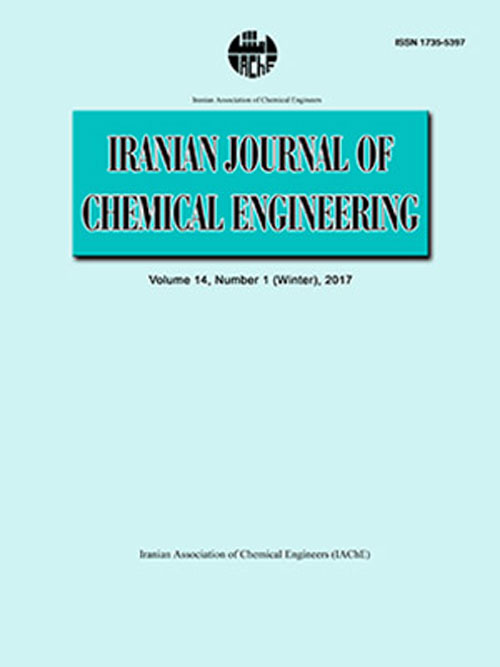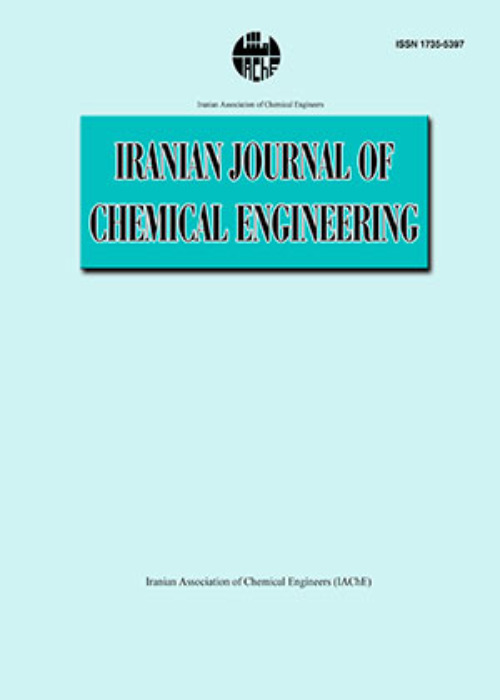فهرست مطالب

Iranian journal of chemical engineering
Volume:14 Issue: 1, Winter 2017
- تاریخ انتشار: 1396/01/05
- تعداد عناوین: 7
-
-
Pages 3-14Silver sulfadiazine is used to prevent and treat infections of second- and third-degree burns. It kills a wide variety of bacteria. In this study silver sulfadiazine was used in gelatin based electro-spun nano-fibers with various drug to polymer ratios (0, 5, 10, 15 and 20 %). SEM, EDX and FTIR analysis showed that the continuous, bead-free, fine fibers containing silver sulfadiazine as an antibiotic drug were successfully produced. The release profiles of the loaded drug from the produced nano-fibrous dressings were evaluated by an in vitro elution method. It was observed that the sample with 10wt% of gelatin has had the optimum trend of release. Moreover, antibacterial activity of the dressings was evaluated against the pathogenic micro-organisms S.aureus and E.coli in the nutrient agar solid medium. It was obvious that all the samples had antibacterial activity against these two bacteria. The produced silver sulfadiazine loaded gelatin based electro-spun nano-fibrous dressings have the potential for being used in the wound healing applications.Keywords: electro-spinning, gelatin, nano, fibres, silver sulfadiazine, wound dressing
-
Pages 15-25Longitudinal heat conduction is an important parameter in the cryogenic field, especially in cryogenic heat exchangers. In the present work, the parasitic effect of tube wall longitudinal heat conduction on temperature measurement has been studied in cryogenic laminar hydrogen flow. The effects of various parameters such as wall cold end temperature, wall thermal conductivity, gas volumetric flow, and tube wall thickness have been investigated by finite element method. The model was also validated versus the data obtained from experiments. The simulations showed that the temperature decrease in gas flow occurs in the end section of tube length. This section is independent of tube cold end temperature and causes for large temperature measurement error in laminar flows. Results showed that a few millimeters change in temperature sensor position results in measurement errors up to 80 %. The higher tube wall thermal conductivity and tube wall thickness result in higher parasitic effects of longitudinal heat conduction.Keywords: Longitudinal heat conduction, Cryogenic, heat exchanger, parasitic effect
-
Pages 26-39Methanol steam reforming plays a pivotal role to produce hydrogen for fuel cell systems in a low temperature range. To accomplish higher methanol conversion and lower CO production, the reaction was catalyzed by CuZnFe mixed oxides. Various ratios of Fe and Cu/Zn were coprecipitated in differential method to optimize the CuZnFe structure. The sample containing 45Cu50Zn5Fe (Wt. %) revealed its maximum methanol conversion of 98.4 % and CO selectivity of 0.78 % with operating conditions of gas hourly space velocity of 18000 h-1 and steam to carbon ratio of 1.3 at 270 °C. The synthesized catalysts were analyzed by powder X-ray diffraction, N2 adsorption/desorption, temperature programmed reduction, scanning electron microscopy techniques. The results revealed that the prepared samples presented mesoporous structure with different pore size depending on the Cu/Zn/Fe ratios. The results showed that increase in Fe loading to 20 Wt. % empowered methanol conversion and decreased CO selectivity. Moreover, the optimized catalyst activity was kept constant during 17 h time on stream. Besides, operating conditions of gas hourly space velocity and steam to carbon ratios were evaluated.Keywords: Methanol, Steam Reforming, Cu, Zn, Fe, Catalyst, differential Co-precipitation
-
Pages 40-51This paper addresses an experimental investigation in the hydrodynamic behavior of a modified slotted sieve tray. Slotted sieve tray (Push valve sieve tray) is a sieve tray that the push valves have been utilized on the tray deck to eliminate liquid gradients and non-uniformity of liquid distribution on the tray. The air-water system was used in an industrial scale experimental rig with an internal diameter of 1.2 m. The dry pressure drop, total pressure drop, weeping and entrainment of the modified slotted sieve tray were measured and compared with the conventional sieve tray. Weeping and pressure drop data for the tray was correlated. Results show the better hydrodynamic behavior of the modified push valve sieve tray than a conventional sieve tray. This modification can be an effective and inexpensive way to debottleneck sieve tray columns, because it has good characteristic of sieve tray and eliminate the disadvantage of sieve tray by increasing the operating window of the tray.Keywords: Sieve tray, Slotted sieve tray, Push valves, hydrodynamic, weeping, entrainment
-
Pages 52-66This study presents the synthesis of polyvinyl acetate (PVAc) by solution polymerization and its partial hydrolysis to polyvinyl alcohol (PVA) using alkaline alcoholysis. The influence of the molar ratio of hydrolysis catalyst (NaOH) to PVAc and the time and temperature of the saponification reaction on the degree of hydrolysis and molecular weight of the PVA were investigated using response surface methodology. Statistical analysis of the results revealed that the degree of hydrolysis and molecular weight of PVA were strongly dependent on the molar ratio of NaOH/PVAc. It was also found that the second-order interactions between the investigated parameters were not statistically significant. The optimal conditions for synthesizing PVA as a primary suspending agent were obtained as T = 45°C, t = 33 min and NaOH/PVAc (molar ratio) = 0.05. The chemical structures of the PVAc and the optimum PVA were studied by Fourier transform infrared spectroscopy. The distribution of acetate groups in the optimum PVA was determined using 13C nuclear magnetic resonance spectroscopy. It was found that addition of benzene as well as one-step addition of NaOH (when compared with drop-wise addition) result in more blockiness in the acetate group distribution of PVA. The performance of the optimum PVA was also investigated for a typical suspension polymerization of vinyl chloride and the particle morphology of the product was studied using scanning electron microscopy.Keywords: polyvinyl alcohol, hydrolysis degree, suspending agent, response surface method
-
Pages 67-73In this paper, LaBO3 perovskite type catalyst formulations were prepared by sol-gel auto combustion method using citric acid as the fuel. Activity of catalysts was tested in catalytic oxidation of toluene as a model of volatile organic compounds. LaCoO3 perovskite formulation showed the highest activity among LaBO3 (Fe, Mn and Co) perovskite catalysts. So, LaCoO3 perovskite based catalyst was selected for further investigation and modification in order to improve catalytic activity. LaBO3 perovskite catalysts were modified by substitution of Co by Fe and Mn. The catalytic activity of LaCoO3 improved due to partial substitution of Co by Fe and Mn cations. LaCo0.7Mn0.3O3 showed the highest catalytic activity among the synthesized catalysts. The structures and morphology of synthesized perovskites were investigated by X-ray diffraction (XRD) and scanning electron microscopy (SEM) analysis. The results of X-ray diffraction indicated that the LaBO3 and LaCo0.7B′0.3O3 samples obtained using sol-gel method had a pure perovskite-type crystal structure.Keywords: VOC oxidation, Perovskite, LaBO3, Sol-Gel
-
Pages 74-87In the present study, the effects of four factors including initial sulfide concentration (mg l-1 ), agitation speed (rpm), amount of inoculums (%) and sodium concentration (mg l-1) on removal efficiency (%R) and yield of sulfate production by Thioalkalivibrio versutus from synthetic spent caustic were investigated. For this purpose, experiments are designed by design of experiments (DOE) and Response Surface Methodology uses results of experiments to determine relationship between experimental factors and measured responses. The coefficient of determination (R2) was calculated as 0.9012 and 0.9544 for removal efficiency (%R) and yield of sulfate production (Y_(SO4/S)), respectively. The best local maximum was found to be at initial sulfide concentration 1500 mg/l, agitation speed 180 rpm, inoculum 8%, Na concentration 1.38 M , removal efficiency 96.99%, yield of sulfate production 2.65 and desirability of 0.909. According to these observations and results Thioalkalivibrio versutus is a suitable bacterium for oxidation of sulfide in spent caustic wastewater.Keywords: spent caustic, Haloalkaliphiles, sulfide, Thioalkalivibrio versutus, Response Surface Methodology


